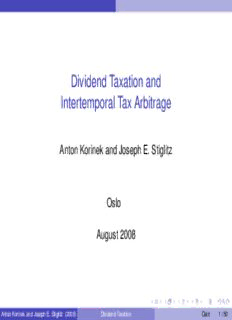
Dividend Taxation and Intertemporal Tax Arbitrage PDF
Preview Dividend Taxation and Intertemporal Tax Arbitrage
Dividend Taxation and Intertemporal Tax Arbitrage Anton Korinek and Joseph E. Stiglitz Oslo August 2008 AntonKorinekandJosephE.Stiglitz (2008) DividendTaxation Oslo 1/50 Contributions 1 General life cycle theory of the firm under dividend taxation (cid:73) inastochasticworld (cid:73) withimperfectcapitalmarkets 2 Analysis of the impact of dividend taxation: (cid:73) effectsoftemporarydividendtaxcutoninvestmentandoutput likelytobeadverse 3 Political economy for contestable democracies: (cid:73) thereisnosuchthingaspermanentpolicies (cid:73) thishasfirstorderimplicationswheneverprivateagents’actions entailintertemporaleffects AntonKorinekandJosephE.Stiglitz (2008) DividendTaxation Oslo 2/50 Motivation Motivation Fierce debate over the effects of dividend taxation (cid:73) Traditionalview: taxationdistortionary (cid:73) Newview: marginalincentivetoinvestisunaffected ⇒ we develop a stochastic life-cycle model incorporating both views Role of capital market imperfections is largely ignored (cid:73) Firm’spayoutpolicyaffectsitsabilitytoinvest ⇒ we analyze the implications of this for dividend taxation Tax policy is analyzed as if changes were permanent (cid:73) Incontestabledemocracynopolicyispermanent (cid:73) Rationalagentsanticipatethis ⇒ we analyze this as an infinitely repeated dynamic game AntonKorinekandJosephE.Stiglitz (2008) DividendTaxation Oslo 3/50 Overview Overview 1 Analysis of Firms and Effects of Dividend Taxation (cid:73) Constructvaluefunction (cid:73) Describebehaviorundernotaxation/constanttaxation (cid:73) Effectsofunanticipatedchangesintaxation (cid:73) Implicationsofanticipatedchangesintaxation (cid:73) Aggregatebehaviorofthemacroeconomy 2 Political Economy of Dividend Taxation (cid:73) Keydeterminantoffirmbehavior: beliefsaboutfuturetaxrates (cid:73) Futuretaxratesinturndependonpartyrule (cid:73) Markovmodelwithexogenouslyfixedtaxrates (cid:73) Markovmodelwithendogenoustaxrates AntonKorinekandJosephE.Stiglitz (2008) DividendTaxation Oslo 4/50 Life-CycleModelofFirms AnalyticalSetup Key Considerations Holding cash is costly because of agency problems: (cid:73) investors’discountfactorisβ < 1 , 1+r i.e.lessthantherisk-freediscountrate(assumedexogenous) (cid:73) ⇒incentivetopayoutdividendsD t Investment opportunities arrive randomly: (cid:73) Bernoullivariableλ˜ indicateswhetherthereisaninvestment t opportunityattimet (cid:73) Probabilityforinvestmentopportunityisp (cid:73) Ifλ˜ =1,theninvestingI yieldsG(I )=AIα−(1+r)I t t t t t Capital market imperfections: (cid:73) preventfirmsfromquicklyraisingnewcash (cid:73) investmentthusreliesoninternalcashholdingsM : t I ≤M −D t t t ⇒ link between incentive to pay dividends, investment, and output AntonKorinekandJosephE.Stiglitz (2008) DividendTaxation Oslo 5/50 Life-CycleModelofFirms AnalyticalSetup Key Results 1 Firms can be analyzed by looking at three distinct stages: (cid:73) Newfirms: M =0,needtoraisecashinequitymarkets t (cid:73) Youngfirms: 0<M <M∗,retainalltheirearnings t (cid:73) Maturefirms: M ≥M∗,distributealltheirearnings t optimal cash holdings M∗ determined by the trade-off between the cost of holding cash and expected cost of capital constraints 2 Most firms in the economy are mature: Mt ≥ M∗. For these: (cid:73) Theleveloftaxationisirrelevant (cid:73) Unanticipatedpermanentdividendtaxchangeshavenoeffect (cid:73) Anticipatedincreases(decreases)intaxationallowfor intertemporaltaxarbitrageandtemporarilylower(raise)cash holdings,investment,andoutput (cid:73) Probabilistictaxchangeshavesimilareffects AntonKorinekandJosephE.Stiglitz (2008) DividendTaxation Oslo 6/50 Life-CycleModelofFirms AnalyticalSetup Key Results (2) 1 Unanticipated temporary tax changes are equivalent to: (cid:73) unanticipatedchangeinonedirection (cid:73) expectedreversalofthischangeinalaterperiod 2 Effects of unanticipated temporary tax cut: (cid:73) maturefirms: noeffectoftemporarilylowerrate atexpiration: highdividendpayout⇒loweroutputandinvestment (cid:73) youngfirms: temporarilylowerrate: (cid:70) iftaxcutisshort-lived: irrelevant(taxwillberaisedagainbeforefirm makesdividendpayments) (cid:70) iflongenough: initialperiodinwhichnewlyestablishedfirmsraise morecapital,havehigherequitybuild-up,moreinvestmentandoutput atexpiration: highdividendpayout⇒loweroutputandinvestment (cid:73) aggregateeffectdominatedbymaturefirms: ⇒overallnegativeeffectonoutputandinvestment AntonKorinekandJosephE.Stiglitz (2008) DividendTaxation Oslo 7/50 Life-CycleModelofFirms AnalyticalSetup Firms’ Maximization Problem Optimization problem of growing or mature firms under constant dividend tax rate τ: (cid:40) ∞ (cid:41) (cid:88) V(M ) = max E βt (1−τ)D 0 t {Dt,It,Mt+1}∞t=0 t=0 s.t. M = (1+r)[M −D ]+λ˜ G(I ) t+1 t t t t M ≥ I +D t t t D ≥ 0 t with M > 0 given. 0 or, in recursive notation: (cid:110) (cid:111) V(M ) = max(1−τ)D +βEV (1+r)[M −D ]+λ˜ G(I ) t t t t t t Dt,It AntonKorinekandJosephE.Stiglitz (2008) DividendTaxation Oslo 8/50 Life-CycleModelofFirms AnalyticalSetup Firms’ Value Function V(M ) t 5.5 V’ = 1−τ M)t5 V’ > 1−τ V( e u al m v4.5 fir 4 ISS = M∗ I∗ 3.5 0 0.5 1 1.5 2 cash holdings M t Figure: ThevaluefunctionV(M )canbedeterminediterativelyfromfirms’ t maximizationproblem. Parametervaluesused: α=1/2,β =0.93,r =0.01, p =1/2,τ =38.6%,AcalibratedsothatISS =1. AntonKorinekandJosephE.Stiglitz (2008) DividendTaxation Oslo 9/50 Life-CycleModelofFirms Steady-StateAnalysis Firms in Steady State Proposition (Steady state investment) The amount of money ISS that a firm in steady state sets aside for investment is defined by a marginal product of β[pF(cid:48)(ISS)+(1−p)(1+r)] = 1 Intuition: Both sides of this equation can be multiplied by (1−τ) Resulting equation: discounted expected benefit of holding cash = cost of paying out dividends Note: without capital constraints, optimum investment is F(cid:48)(I∗) = 1+r The two solutions coincide if β = 1 , otherwise ISS < I∗ 1+r AntonKorinekandJosephE.Stiglitz (2008) DividendTaxation Oslo 10/50
Description: